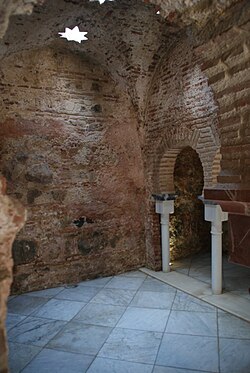| Arab Baths | |
|---|---|
| Native name Baños Árabes (Spanish) | |
 Inner chamber of the Arab Baths in the plaza de la Paz, Ceuta | |
| Location | Ceuta, Spain |
| Coordinates | 35°53′22″N5°18′23″W / 35.88958°N 5.306493°W |
| Official name | Baño árabe de la plaza de la Paz |
| Type | Non-movable |
| Criteria | Monument |
| Designated | 2007 |
| Reference no. | RI-51-0012081 |
The Arab Baths in Ceuta, Spain are medium size medieval public baths on the northern edges of the Medina quarter. This is thought to have been occupied since the 11th century. Archaeological investigations in 2000 and 2004 have shown that the baths had one room for clothes and toilets followed by a cold bath and then a hot bath in a style laid down by the Romans. Other rooms may have existed.

